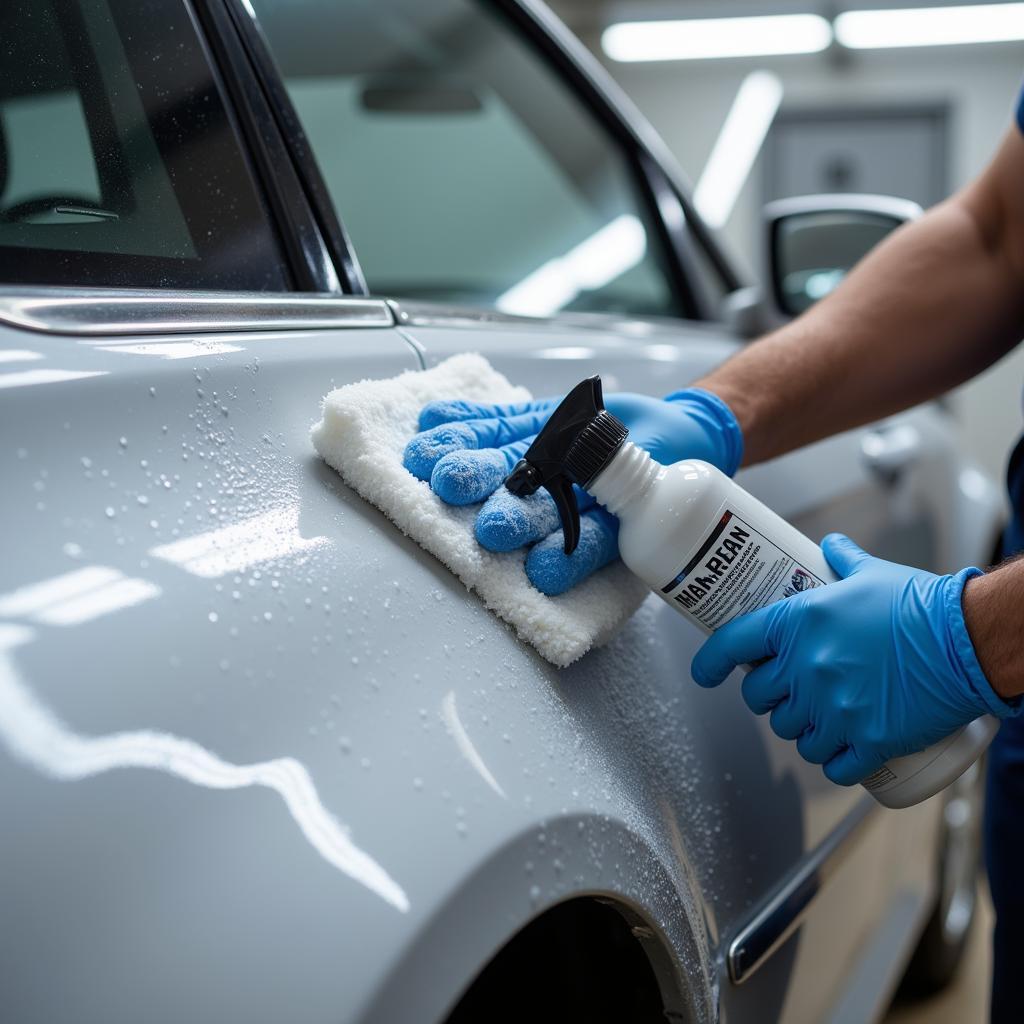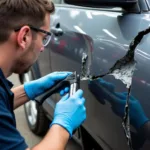Home repair car paint work can seem daunting, but with the right knowledge and tools, you can achieve professional-looking results and save money. This guide provides a step-by-step approach, covering everything from assessing the damage to applying the final clear coat. Whether it’s a minor scratch, a stone chip, or more extensive damage, we’ll equip you with the skills to tackle your car paint repair project effectively.
Assessing the Damage and Gathering Supplies
Before you begin your home repair car paint work, carefully assess the extent of the damage. Is it a superficial scratch, a deep gouge, or a chipped area? The type and severity of the damage will dictate the necessary repair process and materials. For minor scratches, you might only need touch-up paint and some polishing compound. Deeper damage may require sanding, priming, and even body filler. Once you have a clear understanding of the damage, gather the necessary supplies. This could include sandpaper, masking tape, primer, car paint (matched to your car’s color code), clear coat, polishing compound, and applicators.
Once you’ve determined the extent of the damage, creating a clean workspace is crucial for achieving a flawless finish. Thoroughly wash the damaged area with soap and water, removing any dirt, grease, or wax. Then, use a degreaser to ensure a pristine surface for the paint to adhere to properly. This preparation step is essential for a successful home repair car paint work project.
Repairing Minor Scratches and Chips
Minor scratches and chips are the most common type of car paint damage. These can often be repaired with touch-up paint and a bit of patience. First, clean the area thoroughly. Then, apply the touch-up paint carefully, using a fine-tipped brush or a touch-up pen. Allow the paint to dry completely, and then use a polishing compound to blend the repaired area with the surrounding paint. If you need guidance on repairing bumper paint specifically, you can find more information on our page about how to repair paint damage on car bumper. For those in the Portsmouth area, check out our mobile car paint repair portsmouth services for professional assistance.
For slightly more significant scratches that have penetrated the clear coat, sanding might be necessary. Use fine-grit sandpaper (2000-grit or higher) and wet sand the area to smooth out the scratch. Be careful not to sand too aggressively, as you could damage the surrounding paint. Once sanded, you can then apply touch-up paint and polish as described above.
Tackling Deeper Damage
Deeper damage, such as dents or large chips, requires more extensive repair work. First, you’ll need to sand the damaged area to remove any loose paint and rust. Then, apply body filler to even out the surface. After the filler dries, sand it smooth. Next, apply primer to prepare the surface for painting. Once the primer is dry, you can apply several thin coats of car paint, allowing each coat to dry before applying the next. Finally, apply a clear coat to protect the paint and give it a glossy finish. Need help with bumper paint? Check out our guide on repair car bumper paint for detailed instructions.
Final Touches and Maintenance
After the paint and clear coat have dried completely, you can use a polishing compound to remove any imperfections and blend the repaired area with the surrounding paint. This final step will give your home repair car paint work a professional-looking finish. For those dealing with paint fading, our guide on car paint fading repair provides valuable insights and solutions. If you’re in Plymouth and need professional assistance with scratch repair, consider our car paint scratch repair plymouth service.
John Smith, a renowned automotive paint specialist, advises, “Patience is key when performing home car paint repair. Taking your time and focusing on each step will yield the best results.”
Jane Doe, another expert in the field, adds, “Don’t be afraid to practice on a less visible area of your car before tackling the main repair. This will help you get comfortable with the process and materials.”
Conclusion
Home repair car paint work can be a rewarding experience, saving you money and giving you the satisfaction of a job well done. By following the steps outlined in this guide and using the right materials, you can achieve professional-looking results and keep your car looking its best. Remember, meticulous preparation and attention to detail are essential for a successful home repair car paint work project.
FAQ
-
Can I use any type of car paint for touch-ups?
No, you should always use car paint that is specifically matched to your car’s color code. -
How long should I wait between coats of paint?
Refer to the paint manufacturer’s instructions for the recommended drying time between coats. -
What type of sandpaper should I use for wet sanding?
Use fine-grit sandpaper, such as 2000-grit or higher, for wet sanding. -
Do I need to apply a clear coat after painting?
Yes, a clear coat protects the paint and gives it a glossy finish. -
How can I prevent future paint damage?
Regular washing and waxing can help protect your car’s paint from the elements.
Common Scenarios and Questions
Scenario: Small rock chip on the hood.
Question: Can I just use touch-up paint? Answer: Yes, for small chips, touch-up paint is often sufficient.
Scenario: Deep scratch exposing the metal.
Question: Do I need body filler? Answer: Yes, for deep scratches that expose the metal, body filler is necessary to even out the surface before painting.
Further Reading
For more information on related topics, check out our articles on how to repair paint damage on car bumper and car paint fading repair.
Need Help?
Contact us via WhatsApp: +1(641)206-8880 or Email: [email protected]. Our 24/7 customer support team is ready to assist you.



